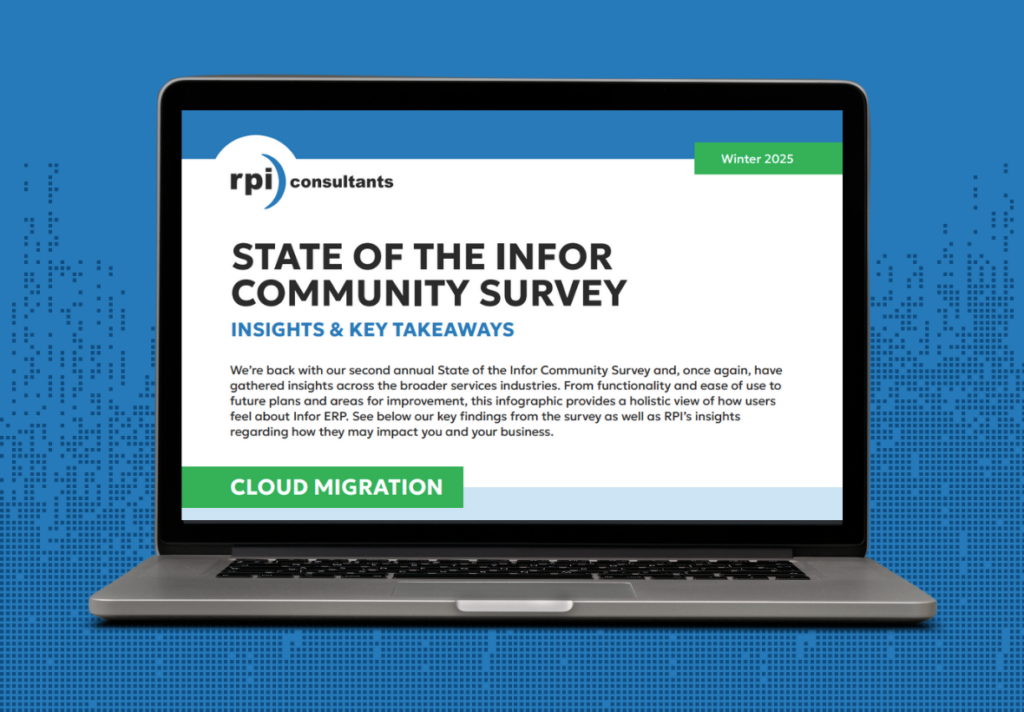In December of 2024, RPI Consultants conducted an in-depth survey to assess the experiences and perspectives of service industry professionals using Infor ERP systems.
Our second annual State of Infor Community Survey explored key topics such as the Infor solutions organizations rely on, their cloud adoption strategies, and areas where Infor can strengthen its products and services.
The objective of this survey is simple: to understand the overall Infor customer experience and gain a deeper understanding of areas of satisfaction as well as improvement. We believe that by conducting this survey each year, we foster a more engaged and informed community.
After thorough analysis and collaboration to identify meaningful insights, we’re excited to present the top five takeaways for our Winter 2025 survey.
To access the full survey results, as well as key RPI Insights explaining the impact these data points have on organizations like yours, download our State of the Infor Community Infographic, or continue reading to find out the five takeaways.
Takeaway 1: Increasing Confidence in Infor CloudSuite
Satisfaction with Infor is on the rise, and organizations are increasingly confident in their plans to move forward with CloudSuite as their ERP of choice.
As 2030 approaches, optimism around Infor’s capabilities and future growth remains strong, as demonstrated by the data collected. Over 54% of respondents currently on legacy Lawson plan to move to Infor CloudSuite for financial management, and nearly 58% for human resources management.
Our survey findings also capture the sentiment of those who have already migrated to the cloud, with results indicating strong levels of satisfaction. Over 50% report that after transitioning, they have seen improved updates and system access related to their job.
What do these two findings say about Infor CloudSuite? That the benefits are real and that confidence in the product’s direction is promising.
Takeaway 2: Process Optimization is a Constant
Another key finding from our survey this year is the amount of optimization organizations are prioritizing. Over 70% of respondents confirm that they have “made process optimizations to their ERP system in the past year.”
This finding was affirming for RPI, as we encourage organizations to adopt a continuous improvement mindset when it comes to their ERP system. There is always a better, faster, more efficient way to execute business operations, and there is an opportunity to do so at every stage of the ERP life cycle.
If you’re considering process optimization, one of the best times to begin an initiative like this is right after going live on a new system. Leading up to cutover, your focus has been on ensuring system stability and that applications are operational. The post go-live phase is an opportunity to configure and dial-in your processes.
Takeaway 3: Reporting Improvements
Last year, respondents indicated that they would like to see reporting improvements. In a year-over-year comparison, satisfaction is improving, with 30% of respondents noting enhancements.
Moreover, when asked where Infor could improve in this year’s survey, only 41% of respondents indicated reporting capabilities, which is down significantly from 62% last year.
So, with reporting capabilities improving within CloudSuite, it begs the question: Why? The answer can be found by taking a closer look at each of the cloud system’s functional areas.
One major enhancement is the ease of customizing reports. Users can now start with a simple list view and, with minimal effort, create tailored reports that are accessible in the Report Catalog. This feature has always been available in CloudSuite but is now gaining broader adoption, with clients recognizing its value post-implementation.
Infor also introduced the Consolidated Webapps in Human Resources, making reports more accessible by centralizing them in a single location rather than burying them within individual modules.
Additionally, new Financial Reporting (BI FSM) reports have become favorites among finance teams, offering deep insights such as Remaining Budget Evaluation reports that compare budget vs. actuals with encumbrances.
Organizations are also embracing tools like GL Report Designer to replace custom reports, significantly reducing RICE Inventory objects. Similarly, some FSM projects now rely entirely on list view reports and standard reports without needing custom App Studio reports.
While Infor has indeed introduced practical improvements, a key factor in this progress can also be attributed to user adoption. As organizations become more comfortable with Infor’s evolving reporting tools, they are tapping into more of their potential, leading to a noticeably improved reporting experience. Savvy customers are also taking a holistic approach to reporting, leveraging complementary solutions to support Infor’s out-of-the-box functionality.
Takeaway 4: Training & More Training
Our survey asked respondents about the different types of Infor events available to them and what they would like to see more of. Nearly 63% indicated that they would like to see more training events.
What’s interesting here is that when asked what ERP improvements organizations are making, only 36% reported training sessions. Perhaps the lack of investment into ERP training can be attributed to a lack of opportunities to engage? Tune into RPI Tech Connect next week to find out!
Virtual events were also a big request from survey respondents, with 50% saying they would like to see more going forward. Fortunately, Infor and its partners are meeting customers where they are by providing both in-person and hybrid training events, like RPI Bootcamps and Lunch & Learns.
These are a great way to level up skills with Infor CloudSuite applications as well as career development.
Takeaway 5: Anticipation for AI & RPI Exclusive Insights
It’s no secret that artificial intelligence (AI) is changing the way users carry out their job duties. Despite the many disruptions and developments, only 20% of respondents cite using AI as a part of their job.
There’s strong anticipation about its potential to positively impact the way people work in the future, though, notably to reduce manual tasks, automate complex workflows, and provide deeper insights through stronger data analysis.
To find out more about how respondents feel about AI, as well as how these takeaways could affect your business going forward, download the State of the Infor Community Infographic below.
Download Infor Community InfographicAbout RPI’s Survey Respondents
RPI’s State of the Infor Community Survey was administered from December 2024 to January 2025. Supply Chain, HR, Finance, and IT professionals across Infor Utilities, Government, Healthcare, Education, and other services sectors participated in our annual survey.



